In an era where economic uncertainty clouds consumer spending, Domino’s Pizza is positioning itself as a daring leader, leveraging aggressive discounts and innovative product introductions to outmaneuver competitors. CEO Russell Weiner’s confident assertion that current industry headwinds serve as “tail winds” rather than obstacles reveals a calculated optimism rooted in strategic risk-taking. Rather than simply following the trend of discounting, Domino’s is attempting to redefine value in a way that appeals to a broad audience, including those with limited income. This bold approach signals a shift in the traditional fast-food paradigm, emphasizing not just price-cutting but a nuanced understanding of evolving consumer needs.
The recent surge in sales, buoyed by the debut of stuffed crust pizza and the widely promoted $9.99 “Best Deal Ever,” underscores Domino’s willingness to challenge norms. Ever since the company’s leadership uncovered the psychology of consumer value—where customers are increasingly willing to spend only on what truly matters—Domino’s seems committed to tailoring its offerings to this new mindset. Such strategies indicate a deep comprehension of the macroeconomic conditions influencing dining choices: consumers are more pragmatic, prioritizing quality, convenience, and perceived value over brand loyalty or indulgence.
Challenging Industry Assumptions on Consumer Behavior
What’s particularly striking about Domino’s current strategy is its focus on capturing lower-income consumers—a demographic often perceived as the most price-sensitive and therefore the most likely to cut back during economic downturns. Counter to industry trends that see budget-conscious consumers opting to eat at home or forego dining out altogether, Domino’s claims to have successfully grown sales across all income cohorts, demonstrating that targeted value propositions can bridge these gaps.
This nuanced market approach raises questions about whether the traditional fast-food model is sustainable in its existing form. Fast-food giants like McDonald’s, KFC, and Pizza Hut have relied heavily on promoting value menus and combo deals to lure consumers. Yet, Domino’s insight goes beyond simple discounts; it aims for strategic perception shifts. By emphasizing quality, ordering convenience, and a tailored value proposition—offering consumers what they want rather than what is cheapest— Domino’s occupies a middle ground that could redefine competitive standards.
However, such daring pricing strategies are not without risks. Weiner himself admits that if prices rise too sharply, Domino’s delivery model could become less attractive compared to the simple convenience of eating at home. The fine balance of discounting without eroding margins or damaging brand perception is delicate, and missteps could alienate core customers or result in profit erosion.
The Hidden Challenges Behind the Promise of Growth
Despite promising sales figures, Domino’s faces clear hurdles that threaten its optimistic outlook. The recent earnings report reflected a not-insignificant setback: earnings per share fell below Wall Street estimates, partly due to a substantial charge related to investments in its China licensee. This illustrates the fragility of reliance on international ventures and the unpredictable nature of growth markets.
More generally, the core challenge remains rooted in the economic landscape itself. If wage growth stagnates and inflation persists, consumers may become even more cautious, restricting their dining-out budget. Domino’s’ bet that consumers will always seek value might be overly optimistic if the fundamental economics of household income do not improve correspondingly.
Another subtle obstacle is the potential for market saturation and diminished brand differentiation. While Domino’s seeks to position itself as a value leader, competitors are also recalibrating their offerings, often with similar strategies. The question then becomes: will aggressive discounting erode industry margins and create a race to the bottom? Or can Domino’s maintain its edge by emphasizing quality and convenience, even at higher price points?
Ultimately, Domino’s strategy embodies a complex gamble—one that could either reshuffle the power dynamics of fast food or expose the industry to a new cycle of price wars and diminishing returns. It challenges assumptions about consumer loyalty, the sustainability of discount-driven growth, and the adaptive capacity of established brands in an economic climate that favors pragmatism over indulgence. As the company navigates these turbulent waters, the real test will be whether this bold approach can deliver on its promise of sustained growth without undermining the very fundamentals it seeks to capitalize on.

